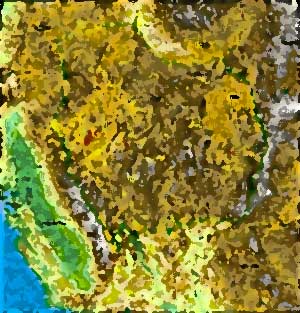BAC
VAI Nevada Neighbors
Program
William L. Fox Essay

—
Telephone Poles
—
When people ask me what I write about, my favorite reply is "cognitive
dissonance in isotropic spaces." I deploy such an alarming statement because
it's accurate, but also because it usually induces curiosity, my favorite
state of arousal for an audience. It all began innocently enough with
my friend, the painter Mary Ann Bonjorni, telling me about counting telephone
poles.
In the early 1990s I was writing a book about contemporary artists in
Nevada, and I'd just finished an essay about Jim McCormick, a Reno printmaker
who had assembled this astonishing topography at the University of Nevada
art gallery out of 930 one-foot-square gridded blocks. The white blocks
with their one-by-one-inch printed grids took up half of the gallery floor,
and the audience sat in the black painted room to contemplate the basin
and range of this situation. Between them and the landscape—because
that's what it was, a landscape print, though not a traditional one—were
small sculptures made to resemble surveying instruments.
Jim had moved to Reno from Tulsa in 1960 to join an art faculty still
housed in quonset huts on campus, and he'd been struck dumb when he entered
the Great Basin. If you're of average height, as is Jim, and live in a
place as flat as Oklahoma, you can see about two miles in any given direction.
That's sixteen square miles you can grasp visually. When he drove into
Nevada on old Highway 40, he could see mountain ranges forty miles away,
and suddenly he was looking at the boundaries surrounding 6,400 square
miles. Between that apprehension of immense space, and what he called
a "drought of color," he had come smack up against the inability of his
mind to process land into landscape, of turning an unfamiliar space that
looked much the same in all directions into a familiar place. He was,
in short, experiencing cognitive dissonance in an isotropic space.
Human beings evolved over millions of years in the woodlands and savanna
of temperate Africa, a terrain where there are trees to hide behind, and
other trees close enough to us to run up into when we're being chased
by something higher up the food chain than we are. We like to see a pond
or stream in the midground of our vision because that's where we find
water and food. We know how far everything is because we understand the
length of our limbs in relationship to the limbs of the trees. And in
the far background we like to see something that defines the horizon,
preferably a mountain range that has gone blue and hazy in the distance—a
shift in the spectrum caused by humidity in the atmosphere, an effect
that Leonardo Da Vinci observed and then used in art for the first time
in the background of the Mona Lisa.